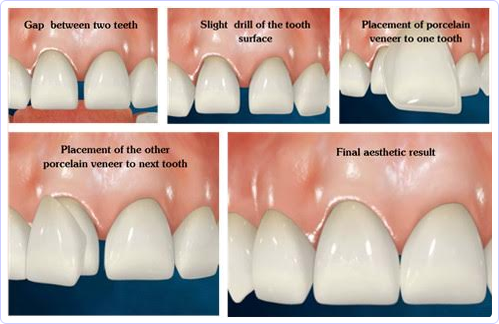All about Porcelain Veneers
Cosmetic dentistry can work wonders with porcelain veneers. Dental porcelain veneers cover teeth that are worn down, chipped, broken, misaligned, uneven, or irregularly shaped. People who have small teeth may also opt for cosmetic dentistry wherein the gaps between teeth are covered with dental porcelain veneers.
They are routinely used to fix teeth that are discolored due:
- Root canal treatment
- Tetracycline antibiotics
- Coffee
- Cola
- Aging
Cosmetic dentistry has progressed so far ahead with dental porcelain veneers that they could serve as a substitute for traditional braces and to cover up awkwardly shaped teeth. In cosmetic dentistry, dental porcelain veneers may be used to correct and improve the appearance of each tooth independently or to restore the entire set.
The Unparalleled Advantages of Porcelain Veneers
Dental porcelain veneers are custom-made ceramic shells, designed to have the same translucency, color, shade and texture of natural teeth. They are
- Durable
- Stain resistant
- Transparent
- Can be easily bonded permanently
- Suit people seeking cosmetic dentistry for aesthetic purposes
- Are compatible for damaged, crooked, chipped, and broken front teeth
Porcelain veneers are often called instant orthodontics because they give people the much sought after ‘perfect smile’ in a couple of sittings, as opposed to an average three-year treatment in regular orthodontics.
You too can get that perfect smile with porcelain veneer treatment.
Treatment Procedure
The entire procedure is simple, and should ideally be completed in two to three sittings.
First Visit – Your dentist will sit with you and discuss the shape, size, color and other parameters of the smile you wish to have. The dentist may also make preliminary impressions of your teeth to help them study your teeth in greater detail.
Second Visit – Dental porcelain veneers usually do not require anesthetizing your teeth, as the procedure is painless. Your dentist may remove a miniscule quantity of enamel from the tooth surface if required and will then make a model of your tooth and send it to a dental laboratory that will construct your veneer in 5-6 days. Temporary dental veneers can be placed if required for quick, temporary fixes till the permanent dental porcelain veneers are ready.
Final Visit – Once the permanent porcelain veneers are ready, the final stage of your cosmetic dentistry treatment commences. Your dentist will examine the fit of your permanent veneer, and may remove or trim it to achieve a perfect fit. The dentist will then clean and prepare your teeth to make them more suitable for bonding with the dental porcelain veneers. Special cement is applied to the veneer and the veneer is then placed on your teeth. Once the veneer is in place, your dentist will activate chemicals in the cement causing them to harden or cure instantly. The dentist will finally remove any excess cement and make final adjustments in the veneer as necessary.
You may have to come for a follow-up visit in a couple of weeks to check how your gums are responding to the treatment and also to get the dental porcelain veneer’s placement examined. Porcelain veneers are minimally invasive as compared to dental caps and crowns.
Veneer Longevity
Although they are termed permanent, dental porcelain veneers do not last a lifetime and will eventually need to be replaced. Usually, they last for 5-10 years, but with good care, regular flossing and cleaning, and hygiene checkups, cosmetic dentistry porcelain veneers can last up to as much as 15 years!
If you want a whiter and fuller smile that is free of gaps and chips, call us today!
XL Smiles Dental Clinic – Your Smile Specialist
Reasons to opt for veneers
- Gaps between teeth
- Worn out teeth
- Deeply stained teeth
- Irregularly shaped teeth
- Mildly crooked teeth
- Chipped, broken teeth


